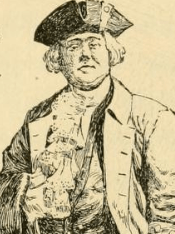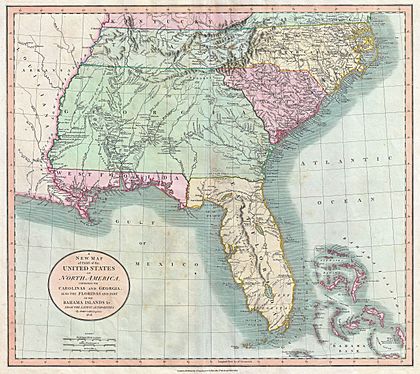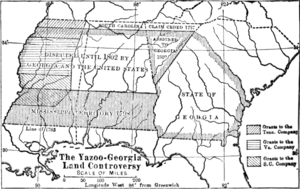George Mathews (soldier) facts for kids
Quick facts for kids
George Mathews
|
|
|---|---|

1896 illustration of George Mathews.
|
|
| Governor of Georgia | |
| In office November 7, 1793 – January 15, 1796 |
|
| Preceded by | Edward Telfair |
| Succeeded by | Jared Irwin |
| Member of the U. S. House of Representatives from Georgia's 3rd district | |
| In office March 4, 1789 – March 3, 1791 |
|
| Preceded by | Position established |
| Succeeded by | Francis Willis |
| Governor of Georgia | |
| In office January 9, 1787 – January 26, 1788 |
|
| Preceded by | Edward Telfair |
| Succeeded by | George Handley |
| Georgia General Assembly | |
| Virginia House of Burgesses | |
| In office Did not convene |
|
| Preceded by | Charles Lewis |
| Succeeded by | Position abolished |
| Personal details | |
| Born | August 30, 1739 Augusta County, Virginia Colony, British America |
| Died | August 30, 1812 (aged 73) Augusta, Georgia, U.S. |
| Resting place | St. Paul's Episcopal Church Cemetery |
| Political party | Federalist |
| Spouses |
|
| Relations | Mathews family |
| Residences | Goose Pond Plantation, Wilkes County, Georgia |
| Profession | Planter, politician |
| Signature | |
| Military service | |
| Allegiance | |
| Branch/service | Virginia provincial militia Continental Army United States Army |
| Years of service | Militia: 1774 Continental Army: 1775–1783 U.S. Army: 1810–1812 |
| Rank | |
| Battles/wars | Dunmore's War • Battle of Point Pleasant American Revolutionary War • Battle of Brandywine • Battle of Germantown • Seminole Wars • Patriot War of East Florida |
George Mathews (August 30, 1739 – August 30, 1812) was an important American soldier and politician. He was a high-ranking officer in the Continental Army during the American Revolutionary War. He also served as the Governor of Georgia two times and was a U.S. Representative for Georgia. Later in his life, he played a key role in the Patriot War of East Florida, an effort to add Spanish Florida to the United States.
Contents
Early Life and Military Beginnings
George Mathews was born on August 30, 1739, in Augusta County, which was then part of the Virginia Colony. His parents, Ann (Archer) and John Mathews, were early settlers from Scotland and Ireland. His father was a respected leader in the community and a militia captain.
George was one of eleven children. He grew up exploring the woods and learned to deal with dangers from local Native American tribes. He may not have had much formal schooling, as he remained unable to read or write throughout his life. When his father passed away, George inherited a farm of 300 acres.
By 1762, George and his brother, Sampson Mathews, started a business together in Staunton, Virginia. They bought and sold goods, including supplies for the frontier and special items from overseas. Their business grew, and they owned a lot of land.
George Mathews became more involved in public life. He served as a local official and was appointed a captain in the militia in 1766. He became well-known for his bravery in the Battle of Point Pleasant on October 4, 1774. This battle was part of Lord Dunmore's War, fought between Virginia militia and Native American tribes. Mathews was elected to the House of Burgesses, Virginia's assembly, but the assembly was dissolved before he could attend.
American Revolutionary War Service
When the American Revolutionary War began, George Mathews was eager to join the fight. In January 1776, he became a lieutenant colonel in the 9th Virginia Regiment of the Continental Army. His regiment joined General George Washington's army in December 1776. By February 1777, he was promoted to colonel.
Mathews' regiment first saw major action at the Battle of Brandywine on September 11, 1777. This was the largest and longest single-day battle of the Revolution. The British won, but Mathews' regiment was among the last to leave the battlefield. Some people believe his actions helped save the American army from a complete defeat.
On October 4, Washington attacked the British camp in Germantown, starting the Battle of Germantown. Mathews led a brave charge that captured many British soldiers. However, he pushed so far into the British lines that his regiment became surrounded. He and his entire regiment were captured. Mathews was injured during the fight.
He spent the next four years as a prisoner of war. He was held first in Philadelphia and then on a British prison ship in New York Harbor. Conditions on these ships were very bad. In 1779, he was allowed to live in New York City on a limited release. He worked to improve conditions for other prisoners. He was officially exchanged in December 1781. At the end of the war, on September 30, 1783, he was given the honorary rank of brigadier general.
Political Career in Georgia
After the war, Mathews was impressed by the opportunities in Georgia. In 1783, he moved to Wilkes County, Georgia, and received 1,900 acres of land. He and his wife, Ann Polly Paul, built a home and had eight children.
Because of his strong military reputation, Mathews quickly became a leader in Georgia politics. He was appointed a judge and a town commissioner. In January 1787, he was elected to the Georgia General Assembly. Just three days later, he was chosen as the 20th Governor of Georgia for a one-year term. During his time as governor, he voted to approve the United States Constitution.
After his first term, he was elected to the 1st United States Congress. His time in Congress was not very active, and he was not re-elected in 1791. However, by 1793, he had enough support to be elected the 24th Governor of Georgia.
His second term as governor was more challenging. Georgia had large land claims in its western areas that were hard to protect. In 1794, General Elijah Clarke, a popular Revolutionary War hero, illegally tried to create an independent state called the Trans-Oconee Republic on land reserved for the Creek Indians. President Washington wanted Mathews to remove Clarke. Mathews was at first hesitant because he understood Clarke's goals and Clarke was popular. But public opinion changed, and Mathews eventually sent Georgia militia to force Clarke to surrender.
Another big issue was the Yazoo Land Fraud. The Georgia legislature wanted to sell its western lands. Some private groups offered to buy 35 million acres for a very low price. Mathews initially said no. However, these groups bribed many Georgia politicians. Under pressure, Mathews eventually signed the bill. When the public found out, they were very angry. Even though Mathews did not personally benefit from the bribes, he was seen as responsible. Jared Irwin replaced Mathews as governor and quickly canceled the Yazoo Act.
Mathews never held public office again. He moved to the Mississippi Territory where his wife owned property. He continued to be involved in land deals. In 1798, President John Adams appointed him as the first governor of the Mississippi Territory. But this appointment was withdrawn because Mathews had financial interests in the territory.
The Patriot War of East Florida

In 1810, George Mathews learned that Spain might be willing to give up West Florida to the United States. President James Madison was interested in expanding the U.S. and wanted to try to get both West and East Florida.
Madison and Mathews met in Washington, D.C. in January 1811 to plan how to take over Florida. Madison gave Mathews instructions that were not very clear. Mathews was told to encourage a rebellion among Spanish citizens if needed, and then accept any land these rebel forces took for the U.S. Mathews and another agent, John McKee, set up a network to gather information in East Florida. Mathews often wrote to Secretary of State James Monroe, who encouraged him to continue. Mathews believed that if Monroe didn't reply, it meant the plan was approved, as the government wanted to keep things secret.
Mathews became sick with malaria in the summer of 1811. Spanish authorities found out about his plans and asked the U.S. to stop him. Instead, Monroe publicly stated that the U.S. had a right to East Florida. This made Mathews even more sure that the U.S. government supported him.
By late 1811, Mathews had gathered some wealthy Spanish supporters for his rebellion. But he still needed more fighters. So, he recruited volunteers from Georgia to act as his "Patriots." By early 1812, he had about 125 Patriots. He also planned for U.S. troops at the border to join his forces. However, this plan was discovered, and Mathews realized he didn't have enough men to take the larger city of St. Augustine.
He then decided to attack Fernandina on Amelia Island, which was less protected. On March 13, 1812, Mathews and his Patriots, supported by nine U.S. Navy gunboats, entered Florida. They quickly took over rural lands. Many fighters joined them, bringing their numbers to about 250.
On March 16, the Patriots took control of Fernandina without a fight. They raised a new flag for East Florida. After holding the territory for 24 hours, they handed it over to the United States. Mathews told Madison about his success and said he planned to take Mobile and Pensacola in West Florida next.
Madison's Response
By late 1811, President Madison was preparing for war with Great Britain (the War of 1812). When he heard about Mathews' actions and Spain's anger, Madison worried that it might cause Spain and Britain to join forces against the U.S. Even though Monroe thought Mathews' plan was clever, he and Madison decided that publicly supporting Mathews was too risky.
On April 4, 1812, Madison publicly disowned Mathews and removed him from his duty. Madison then sent Georgia Governor David Brydie Mitchell to take over. Mitchell was told to keep Mathews' Patriot army together and hold the captured areas. Mitchell quickly warned the Spanish governor that the U.S. would not allow any attempts to drive out the Patriots.
Mathews was very angry about being disowned by Madison. He decided to travel to Washington, D.C. to confront them. However, on his way, he became sick again with malaria and had to stop in Augusta, Georgia. He passed away there on his 73rd birthday, August 30, 1812. He is buried in Saint Paul's Church.
Physical Appearance
In 1811, during a meeting with James Madison, George Mathews was described as: He wore an old three-cornered hat, worn knee breeches, and high boots. His shirt had small ruffles. A sword hung at his side. He was short and strong, with muscular legs. He stood straight, with his head back, red hair, and dark blue eyes in a weathered face.
Memorials
Several historical markers in the United States honor George Mathews.
- The Battle of Point Pleasant monument in Mason County, West Virginia, lists him as a captain.
- A marker stands at the site of his Georgia home, "Goose Pond," in Oglethorpe County, Georgia.
- Another marker in Greene County, Georgia, marks the site of Fort Mathews.
- A marker in Elbert County, Georgia, recognizes his role in settling that county.
Images for kids
See also
 In Spanish: George Mathews para niños
In Spanish: George Mathews para niños




